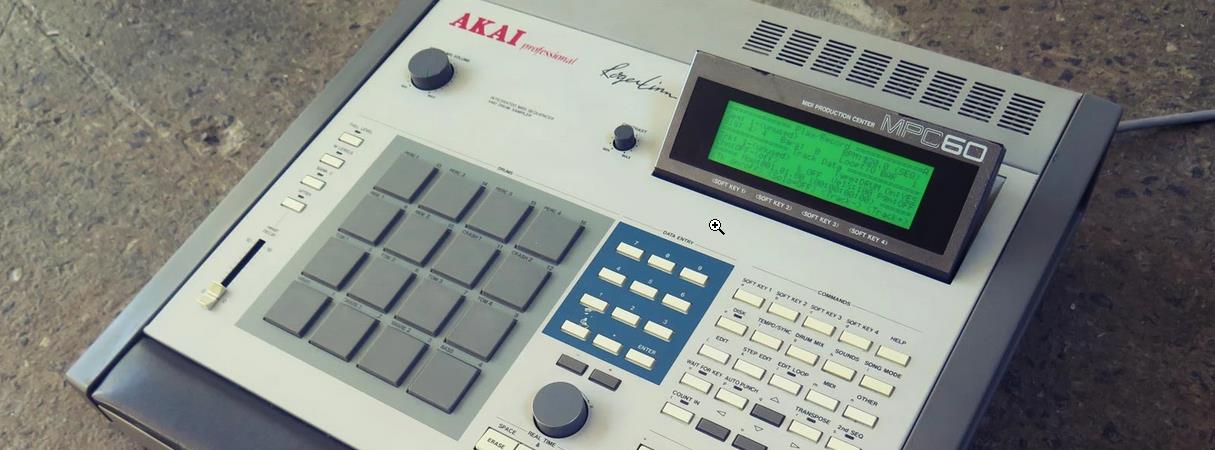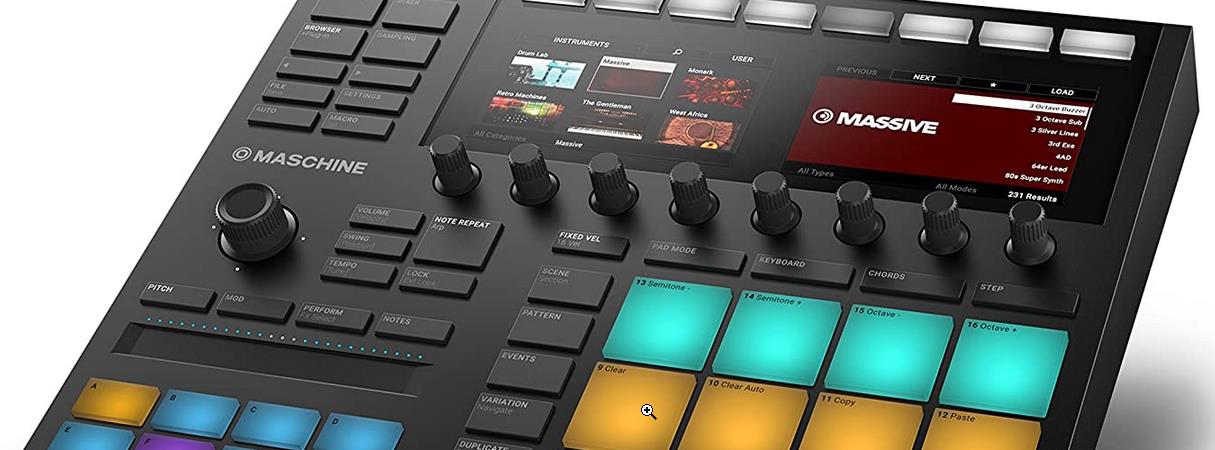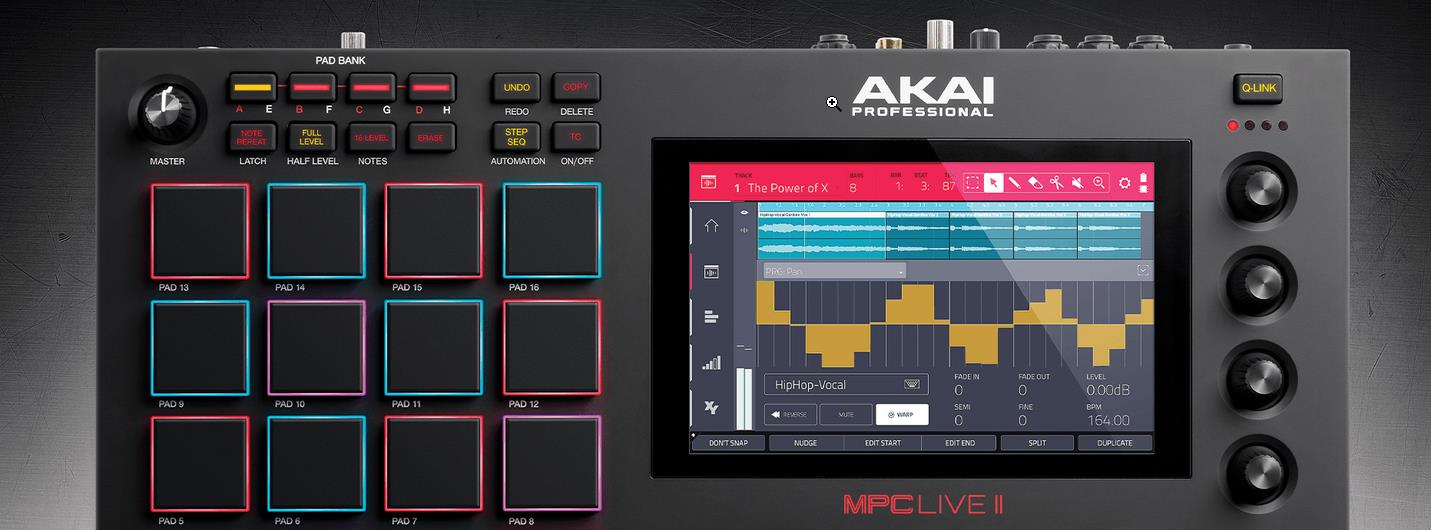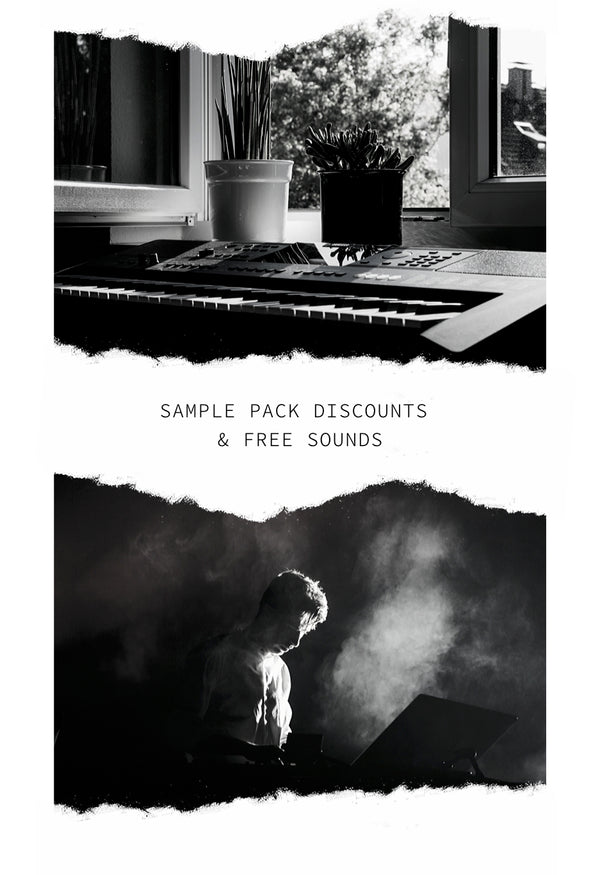Your Cart is Empty
⚠50% off code: SAMP50⚠
⚠50% off code: SAMP50⚠
⚠50% off code: SAMP50⚠
by Anders Johanson January 16, 2021 9 min read
Drum machines have emerged as a recent innovation in the music industry. Acting as electronic devices, they are capable of playing pre-programmed drum beats. Irrespective of the preference for individual beats or a complete drum track, drum machines can be easily configured according to the desired musical piece. Several well-known songs, such as "Take On Me" by a-ha and "Autobahn" by Kraftwerk, have exclusively utilized drum machines for all the percussion elements. The origins of drum machines can be traced back to the late 1960s, when they were first introduced. Early versions of these instruments offered limited drum beats and were typically preset to perform a short drum solo. To switch to a different drum pattern, the user had to manually manipulate a knob. However, advancements in technology have rendered it possible for drummers to program entire songs using these machines.
Drum machines and MPCs share a common objective: they enable you to effortlessly play pre-programmed drum beats and sequences. Nonetheless, an MPC offers a significantly higher level of customization when compared to a drum machine. You have the freedom to allocate any desired sound to each pad, and even have the ability to combine multiple sounds simultaneously. What's more, you can fine-tune the sensitivity of the pads according to your preference. Additionally, an MPC seamlessly integrates with nearly any other instrument in your arsenal, be it a keyboard or a guitar. Considering the fact that a drum machine is specifically designed for drums, it will come with limited choices and may not possess a high level of sensitivity. Regrettably, an MPC is priced at several thousand dollars. However, a preowned drum machine can be acquired for less than $500, making it a more budget-friendly option for the majority of musicians.
DAW), which allows musicians to create and manipulate different elements of the music with ease. This technological advancement has revolutionized the music industry, making it more accessible and diverse than ever before. With the use of digital tools and software, artists can experiment with different sounds, textures, and beats to create unique and innovative compositions. Additionally, the ability to easily edit and rearrange tracks within a DAW has streamlined the music production process, allowing for quicker and more efficient creation. Overall, the integration of technology into music production has transformed the way music is created, pushing the boundaries of creativity and opening up new possibilities for artists. DAWperformance with a drummer can be inconsistent, as human error and fatigue can affect their timing and energy. This is where drum machines come in handy. In the past, drum machines were highly sought after due to their ability to provide a steady and precise rhythm. They were especially popular during times when music software was not as technologically advanced. Drummers play a crucial role in a band, as they are responsible for setting the pace and creating a solid foundation for other musicians to build upon. Their rhythm and beats not only serve as a metronome, keeping everyone in sync, but also act as a source of inspiration, driving the energy and creativity of the music. However, relying solely on a live drummer can sometimes present challenges. Mistakes can happen, and fatigue can affect their performance. This can lead to variations in timing and energy, which may not always be desired. Enter drum machines. These electronic devices are designed to provide a consistent and reliable rhythm, eliminating the inconsistencies that may occur with a human drummer. They offer precise timing and energy that can be easily adjusted and programmed to fit the specific needs of a song. Drum machines have revolutionized the music industry, allowing musicians to create professional-quality beats and rhythms with ease. They also offer a wide range of sounds and patterns, giving artists the freedom to experiment and explore different musical styles and genres. While drum machines cannot fully replicate the unique nuances and expressions of a live drummer, they provide a valuable tool for musicians to enhance their music and create a more polished and consistent sound. Whether used in a studio setting or during live performances, drum machines have become an indispensable asset for many musicians and music producers. drum kitIt can be challenging to find enough space in home studios, and it can also be a hassle to locate a drummer solely for the purpose of cultivating musical ideas.
controllers, customize sounds, and even connect to computers for further editing and production. The evolution of technology has brought about a significant transformation in the capabilities of drum machines.
Drum machines have become an essential tool for musicians, producers, and DJs alike. They offer convenience, flexibility, and endless creative possibilities. With just a few clicks, users can create complex drum patterns, experiment with different sounds, and layer multiple rhythms to create unique compositions.
These innovative devices have revolutionized the music industry by providing a cost-effective and accessible solution for creating professional-quality drum tracks. Drum machines are no longer restricted to professional studios. They have made their way into home studios, live performances, and even bedroom setups.
The user-friendly interface allows users of all levels to easily navigate and program their beats. Whether you're a novice or an experienced musician, a drum machine offers you the freedom to unleash your creativity and express yourself through rhythm.
In conclusion, drum machines have come a long way since their early days. They have evolved into versatile and powerful instruments that play a crucial role in modern music production. Whether you're a drummer looking for practice tools, a producer searching for inspiration, or a DJ wanting to add unique beats to your sets, a drum machine is a must-have tool in your arsenal.
samplesCreate unique drum sounds by synthesizing them yourself.
It is indeed safe to acknowledge that drum machines have undergone significant development, transforming from a modest analog device to a distinct category of musical instruments. Technological advancements such as touch-sensitive pads and integrated effects enable users to exert precise control over even the most minute aspects of the rhythm. While it is undeniable that a drum machine can never completely substitute a live drum kit, the hardware itself does not attempt to compete for the same role and instead charts its own course. Drum machine manufacturers increasingly prioritize offering users extensive sound design capabilities and innovative means of creating distinctive drum patterns. Countless musicians and producers willingly take on the challenge of mastering the intricacies of drum machine workflows, as it resembles the closest embodiment of a musical instrument in the 21st century.
In its purest form, a drum machine functions as a sequencer equipped with preset drum sounds and effects. Additionally, an MPC incorporates all of these components and boasts a distinct feature - an integrated sampler. Early drum machines were quite limiting as they solely allowed for the use of the preloaded sounds. However, the introduction of the MPC brought about a revolutionary breakthrough. While still functioning as a drum machine, it granted users the freedom to utilize any sound they could get their hands on. This newfound independence compelled musicians to sample not just drums and percussion, but also melodies, movie quotes, and innumerable other recordings. Consequently, the MPC transformed the role of the drum machine from a mere electronic substitute for a live drummer to an incredibly versatile device capable of generating a complete instrumental track.
It can be said with confidence that the capabilities of an MPC were always intended to surpass those of a drum machine. This can be easily inferred from its name. MPC stands for Music Production Center, which carries a much more prestigious connotation compared to a sampling drum machine. The inventor of the first MPC, Roger Linn, had already established himself as a skilled designer of drum machines. Before joining forces with Akai, the company responsible for introducing the MPC60 in 1988, Linn had already launched a range of drum machines, with the LinnDrum being particularly successful.

music industry by storm. It embraced simplicity with its user-friendly interface and innovative features, making it accessible to both experienced musicians and newcomers. The MPC60 offered a seamless blending of sampling capability and drum machine functionality, making it a powerful tool for music production.
Linn's determination to create an affordable and reliable drum machine paid off, as the MPC60 became a legendary icon in the music production world. Its impact was so significant that it revolutionized the way artists and producers approached music creation.
The MPC60's enduring legacy lies in its ability to democratize music production. It empowered aspiring musicians to create professional-quality beats and melodies with ease. The introduction of this game-changing device sparked a wave of creativity and transformed the industry.
The MPC60 not only changed the landscape of music production but also inspired countless musicians and producers to push the boundaries of their creativity. Its user-friendly approach and intuitive design made it a favorite among artists across genres, from hip-hop to electronic music.
In summary, the MPC60's arrival marked a turning point in music production history. It broke down barriers and provided a platform for artistic expression that was previously inaccessible to many. Linn's vision of a user-friendly drum machine paved the way for future innovations in the field, forever leaving an indelible mark on the world of music.
Hip-HopThe genre took the world by storm, and even today, the MPC brand is still widely recognized by households.
headphones. This convenience has led to a decline in the traditional approach to beat-making. In the past, producers prided themselves on their ability to spontaneously create music in the studio. They would rely on their skills and instincts to craft a beat that would captivate listeners. It was a true art form that showcased their talent and creativity. However, with the advancements in technology, the process of beat-making has become more streamlined. Producers no longer need to rely on physical instruments or spend hours honing their skills. Instead, they can simply open a digital audio workstation (DAW) on their computer and use pre-made samples and loops to quickly create a beat. While this may be more efficient and less time-consuming, it has also resulted in a loss of the personal touch and spontaneity that once defined beat-making. Producers are no longer challenged to think on their feet and come up with something unique on the spot. Instead, they can easily replicate popular sounds and styles with just a few clicks of a mouse. Additionally, the accessibility of DAWs and other production software has led to a flood of aspiring producers. Anyone with a computer and some basic knowledge can try their hand at making beats. While this has increased diversity and allowed new voices to be heard, it has also saturated the market and made it harder for truly talented producers to stand out. In conclusion, modern technology has greatly changed the landscape of beat-making. While it has made the process more convenient and accessible, it has also led to a decline in the artistry and spontaneity that was once associated with this craft. Producers now rely more on software and pre-made samples, rather than their own skills and creativity. This shift has both positive and negative consequences, and only time will tell how it will continue to evolve. studio monitorsmusic. Observing someone select the melody on a virtual keyboard or listening through headphones. Observing someone play the notes on a digital sheet or listening through headphones. FL Studio or AbletonWatching a talented beatmaker improvising on a drum pad brings a level of excitement that cannot be replicated. Consequently, an increasing number of producers opt to create their beats in the seclusion of their home studios, only revealing the final tracks to the world.
Therefore, the answer to the question is quite simple - you do not require a drum pad or any external hardware except for a computer in order to create beats. The decision of whether or not to use a drum pad while producing solely depends on your personal preference. It is crucial to remember that one of the key aspects of music production is enjoying the process. If you are having fun with what you are doing, there is a greater likelihood that your work will resonate with your audience. Some producers are accustomed to working within a digital audio workstation (DAW). They are familiar with the workflow, and prefer to work alone as it allows them to focus on the creative process. On the other hand, there are producers who thrive off the energy of performing beats spontaneously in front of others, showcasing their beat-making skills, as it enhances their creativity. If you happen to fall into the latter category, it would be highly advantageous for you to invest in a drum pad or an MPC.

A major benefit of possessing a drum pad is that it adds another powerful artistic tool to your collection. Even though a digital audio workstation (DAW) such as A significant advantage of having a drum pad is that it provides an extra innovative instrument in your artillery. Despite the presence of a digital audio workstation (DAW) like FL Studio A unique way to explore music The device possesses a sequencer and a workflow that is based on patterns, much like a drum machine. However, the real game-changer lies in having an actual physical instrument right in front of you. This will unlock an entire world of possibilities. Take, for instance, the ability to trigger multiple sounds on the fly. While a computer mouse cannot achieve this, a drum pad effortlessly eliminates that limitation. By physically touching the pads, you establish a connection with your music that a mouse can never replicate. Consequently, you'll be amazed at the sheer number of fresh ideas you can generate by embracing this alternative approach.
playing drums much easier and more accessible. Drum pads are essentially a set of electronic pads that are designed to mimic the feel and response of real drums. They are typically used in conjunction with a drum module, which generates the sounds of different drums and cymbals. One of the key advantages of drum pads is that they are much quieter than traditional drums, making them perfect for home practice or quiet performance situations. They also take up significantly less space than a full drum kit, making them a great option for drummers with limited space. Another benefit of drum pads is their versatility. With a drum module, you can easily change the sounds of the pads to simulate different drum kits or even create your own unique sounds. This allows for endless possibilities and experimentation with different drum sounds and styles. Drum pads are also a great tool for beginners who are just starting to learn how to play the drums. They provide a less intimidating and more user-friendly interface compared to a full drum kit, allowing beginners to focus on developing their technique and timing without the distractions of multiple drums and cymbals. In conclusion, drum pads are a convenient and versatile option for drummers of all skill levels. Whether you're a beginner looking to learn or an experienced drummer wanting a portable practice solution, drum pads satisfy the need for a quiet, compact, and customizable drumming experience. making beatsfan of a more hands-on and intuitive approach to music making. Drum machines offer a unique experience that allows for greater experimentation and efficiency. With just a few minutes of finger drumming, you can generate a multitude of fresh ideas. In a world where music technology has reached new heights, it's important to remember that the essence of making music has always been about actively engaging with the creative process. If you value this approach, investing in a drum machine will not disappoint. beatmaker Are you seeking the ability to sense the rhythm and construct your loops in a more natural manner? And of course, there is no need to limit yourself to just one tool. You have the option to merge a drum pad with a digital audio workstation (DAW) and enjoy the advantages of both.
The pricing of drum machines greatly fluctuates due to the extensive range of subcategories available. In the realm of affordable options, one can consider the Volca Beats, which is priced at approximately $150. This drum machine encompasses the fundamental features and includes a sequencer, as well as a combination of sampled and synthesized sounds. A comparable alternative is the Volca Drums, which shares a similar price point and focuses exclusively on synthesized drums, providing ample opportunities for sound design exploration.
If you desire increased flexibility, you will need to invest a significantly higher amount. It may present a challenge to locate a Roland TR-8S drum machine, which comes highly recommended, for a price below $700. This remarkable device emulates the renowned sounds of iconic drum machines, such as the 808 and 909. Furthermore, it boasts an impressive collection of over 300 preset samples and allows effortless importation of personalized samples through the utilization of an SD card.
At long last, there exists the utmost tier of drum machines that surpass the $1000 threshold per individual unit. We are referring to hardware such as the MPC Live, which encompasses a drum machine, a sampler, and a Digital Audio Workstation (DAW) all unified within a single enclosure. The MPC Live transcends the conventional boundaries of a standard drum machine, elevating itself to the status of a focal point for your personal studio.
The lineage of MPC drum machines includes several notable models that have made a significant impact in the world of music production. One such model is the MPC60, which is widely recognized as an iconic device that completely transformed the art of music sampling. Subsequent models, such as the MPC2000XL and the MPC3000, also gained immense popularity, particularly within the Hip-Hop community. Renowned producers like Pete Rock and J Dilla have utilized these drum machines to create legendary tracks. Today, if you explore the market, you will encounter the MPC Live II, which stands as the latest and most advanced model available. In the following sections, we will delve into the reasons why the MPC Live II is widely regarded as one of the top drum machines that money can buy.

Akai MPC Live II stands out from other drum pad controllers such as Maschine MK3 or the. AbletonPush serves as its independent feature. Connecting the MPC Live II to a computer and utilizing it alongside the MPC software is optional. The MPC series has consistently been praised for its drum machines that eliminate the need for external hardware. Furthermore, you can operate the MPC Live without connecting it to a wall socket as its internal battery can provide up to six hours of power.
If you are interested in bringing your sampler on a vacation or using it in a DAW-less setting, the ideal option would be the MPC Live II. Picture yourself taking your device to a local record store and immediately sampling vinyl records on the spot - the MPC Live II makes this scenario a reality. Moreover, the drum machine's portability is boosted by the inclusion of a built-in speaker, which is a new feature compared to the first model. Although the speaker may not be optimal for professional mixing decisions, it is certainly adequate for beat-making. Additionally, you always have the option to connect and utilize your headphones instead.
Similar to its predecessors, the MPC Live II showcases 16 drum pads artistically arranged in a four by four grid. The exquisite rubber pads possess velocity sensitivity, enabling a wide range of variation in sample loudness based on the pressure exerted on the pads. Alongside the drum pads, this exceptional model boasts an additional 27 buttons and five knobs, coupled with a prodigious 2GB of RAM as well as 16GB of internal storage. For those who indulge in collecting samples, this capacity may fall woefully short of their needs. However, providentially, a removable plate tastefully concealed beneath the MPC offers a solution. By effortlessly inserting your own SSD, the potential for expanding storage becomes exponentially greater.
Akai Professional MPC Live II, navigating your music production workflow becomes even more intuitive and efficient. The 7-inch multi-touch screen serves as the standout feature of this device, allowing for seamless and rapid access to all essential functions. Whether you're composing, sampling, or mixing, the touchscreen revolutionizes the way you interact with your MPC Live II. Combined with a controller such as the Akai Professional APC40 MkII, your creative possibilities are truly limitless. Maschine MK3You can easily navigate to any function you need on the MPC Live II by pressing buttons and turning knobs. This may be overwhelming for beginners, but experienced users will find it simple. On the contrary, the navigation system on the MPC Live II will feel familiar to those who have used smartphones or tablets before. You can access the step sequencer, effects, sample editing, mixing, sound library, and many other features with just a touch of your fingertips.
Overall the MPC Live IIThe MPC Live II is an excellent drum machine option specifically designed for those embarking on their musical journey. Mastering the device's workflow is a breeze and even newcomers will find themselves creating impressive beats in record time. Thanks to its innovative pattern system, the MPC Live II streamlines the process of translating ideas into fully-fledged songs, allowing users to effortlessly capture and arrange their musical visions. But it doesn't stop there - the device's touchscreen ensures seamless editing of both midi notes and audio samples. Moreover, the drum machine encompasses a wide range of top-notch stock sounds, which prove incredibly useful for those just starting out and lacking an extensive sample library. And for the more advanced users, the MPC Live II offers the exciting opportunity to sync with Splice via WIFI, enabling access to a vast array of additional samples directly on the machine.
by Anders Johanson January 30, 2021 12 min read
Read Moreby Anders Johanson January 30, 2021 11 min read
Read Moreby Anders Johanson January 18, 2021 9 min read
Read More
Sign up to receive exclusive discount codes for our wide range of sample packs. Get access to complimentary audio files delivered directly to your email. Explore our impressive collection of diverse sounds – and there's more! Rest assured, we offer complimentary distribution of our premium audio files. Hurry up, seize this opportunity to enhance your projects with high-quality, cost-free sounds.